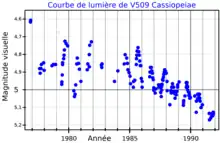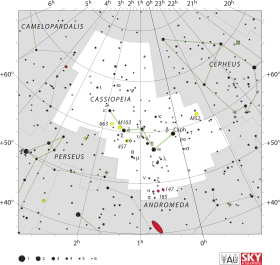V509 Cassiopeiae
V509 Cassiopeiae (V509 Cas ou HR 8752) est une étoile hypergéante jaune dans la constellation de Cassiopée.

| Ascension droite | 23h 00m 05,10122s[2] |
|---|---|
| Déclinaison | +56° 56′ 43,3509″[2] |
| Constellation | Cassiopée |
| Magnitude apparente | +4,6 - +6,1[3] |
Localisation dans la constellation : Cassiopée  | |
| Type spectral | G0Ia0[4] (K5Ia0 - A6Ia+[5]) |
|---|---|
| Indice U-B | +1,33[6] |
| Indice B-V | +1,0 - +1,7[4] |
| Variabilité | SRd[3] |
| Vitesse radiale | −50,20 km/s[7] |
|---|---|
| Mouvement propre |
μα = −3,013 mas/a[2] μδ = −2,213 mas/a[2] |
| Parallaxe | 0,250 7 ± 0,063 3 mas[2] |
| Distance |
4 500[4] al (1 370[4] pc) |
| Magnitude absolue | −8,6 (variable)[4] |
| Masse | 11 M☉[4] |
|---|---|
| Rayon | 400-900 R☉[4] |
| Luminosité | 200 000-400 000 L☉[4] |
| Température | 4 000-8 000 K[4] |
| Métallicité | 0,0[8] |
Autres désignations
V509 Cas, HR 8752, HD 217476, BD+56°2923, FK5 3839, HIP 113561, SAO 35039, AAVSO 2255+56[9]
HR 8752 est à environ 4500 années-lumière de la Terre. Elle a une magnitude apparente qui a varié d'une valeur supérieure à +6 dans les temps historiques à un pic de +4,6 et maintenant autour de +5,3 et est classée comme une étoile variable semi-régulière de type SRd[3]. Elle subit une forte perte de masse dans le cadre de son évolution rapide et est récemment passée à mi-chemin du vide évolutif jaune en éjectant environ une masse solaire de matière en 20 ans. Son rayon est de 650 (400-900) rayons solaires[4].
Un compagne chaude de la séquence principale (B1V) a été décrite en 1978 sur la base d'un excès de couleur dans l'ultraviolet[3].
Références
- (en) J. R. Percy et E. Zsoldos, « Photometry of yellow semiregular variables : HR 8752 (= V 509 Cassiopeiae) », Astronomy & Astrophysics, vol. 263, , p. 123–128 (Bibcode 1992A&A...263..123P)
- (en) A. Vallenari et al. (Gaia collaboration), « Gaia Data Release 3 : Summary of the content and survey properties », Astronomy & Astrophysics, vol. 674, , article no A1 (DOI 10.1051/0004-6361/202243940, Bibcode 2023A&A...674A...1G, arXiv 2208.00211). Notice Gaia DR3 pour cette source sur VizieR.
- (en) E. Zsoldos, « Historical light curve of HR 8752 », The Observatory, vol. 106, , p. 156 (Bibcode 1986Obs...106..156Z)
- (en) H. Nieuwenhuijzen, C. De Jager, I. Kolka, G. Israelian, A. Lobel, E. Zsoldos, A. Maeder et G. Meynet, « The hypergiant HR 8752 evolving through the yellow evolutionary void », Astronomy & Astrophysics, vol. 546, , A105 (DOI 10.1051/0004-6361/201117166, Bibcode 2012A&A...546A.105N)
- (en) A. Lobel, K. De Jager et H. Nieuwenhuijzen, « Long-term Spectroscopic Monitoring of Cool Hypergiants HR 8752, IRC+10420, and 6 Cas near the Yellow Evolutionary Void », 370 Years of Astronomy in Utrecht. Proceedings of a conference held 2–5 April, vol. 470, , p. 167 (Bibcode 2013ASPC..470..167L)
- (en) J. R. Ducati, « VizieR Online Data Catalog: Catalogue of Stellar Photometry in Johnson's 11-color system », CDS/ADC Collection of Electronic Catalogues, vol. 2237, , p. 0 (Bibcode 2002yCat.2237....0D)
- (en) G. A. Gontcharov, « Pulkovo Compilation of Radial Velocities for 35 495 Hipparcos stars in a common system », Astronomy Letters, vol. 32, no 11, , p. 759 (DOI 10.1134/S1063773706110065, Bibcode 2006AstL...32..759G)
- (en) M. A. Fry et L. H. Aller, « A comparison of galactic and Large Magellanic Cloud G-type supergiants by a method of spectrum synthesis », Astrophysical Journal Supplement Series, vol. 29, , p. 55 (DOI 10.1086/190332, Bibcode 1975ApJS...29...55F)
- (en) V* V509 Cas -- Long-period variable star sur la base de données Simbad du Centre de données astronomiques de Strasbourg.
Lien externe
- (en) V509 Cassiopeiae sur la base de données Simbad du Centre de données astronomiques de Strasbourg.